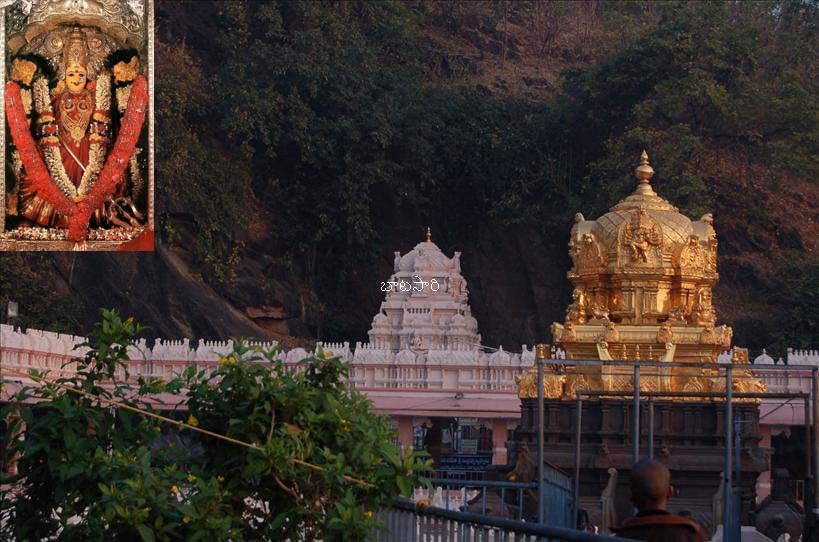Name of the Temple |
|
Location |
- Vijayawāḍa, Āndhra Pradeśh. The temple is located on the Indhrakīlādhri hill, on the banks of Kriṣhṇa River.
|
| How to reach there? |
- By air : The nearest airport is Vijayawāḍā airport located in Gannāvaram, about 20 km away from Kanakadhurgā. From the airport take the National Highway 5 to Vijayawāḍā.
- By train : The nearest railway station is located in Vijayawāḍā itself. The railway station is about 8 km away from Kanakadhurgā. Take the National Highway 9 from the Vijayawāḍā railway station to reach Kanakadhurgā temple.
- By road : Kanakadhurgā is located in Vijayawāḍā and the latter is connected by good roads with all the places within the state. Two National Highways, the National Highway 5 from Chennai to Kolkāthā and the National Highway 9 from Machilipaṭnam to Haidherabādh pass through the city connecting it to other parts of the country.
|
Rulers/builders and Time Period |
- Goddess Kanaka Dhurgā manifested herself (Swayambhu) on the hillock known as Indhrakīlādhri situated on the left bank of River Kriṣhṇa at Vijayawāḍā.
- The origin of this shrine is known to be of 8 th century.
- The temple was constructed during the regime of Moghal rulers. According to Sthalapurāṇam, Moghal Ruler Thanisha with the assistance of his Ministers Akkaṇṇa and Mādhaṇṇa managed the temple with head quarters at Konḍapaḷḷi.
|
Deity/Deities |
|
Architecture Style |
- At the Kanakadhurgā temple, the enchanting 4-foot-high (1.2 m) icon of the deity is bedecked in glittering ornaments and bright flowers.
- She has eight arms, each holding a powerful weapon, and is in a standing posture over the demon Mahiṣhāshura and piercing him with her trident.
- The goddess is the epitome of beauty. Adjacent to the Kanakadhurgā temple is the shrine of Malleśhwara Swāmi on the Indhrakilādhri.
- By ascending the steps on the hill, one comes across little images of different deities; prominent among them are Kāḷi, Śhiva, and Kriṣhṇa.
- This is the place where Arjuna obtained the Pāśhupatha Asthra after his great penance for Lord Śhiva. The temple was constructed for Goddess Dhurgā by Arjuna. It is connected by steps and a ghāṭ road.
|
Other Special Features |
- Sage Indhrakila practiced severe penance and when the goddess appeared the sage pleaded Her to reside on his head and keep vigil on the wicked demons. As per his wishes of killing the demons, Goddess Dhurgā made Indhrakila Her permanent abode.
- One of the many mythologies associated with this place is that Arjuna prayed to Lord Śhiva on top of Indhrakilādhri to win His blessings and the city derived its name "Vijayawāḍa" after this victory.
- Another popular legend is about the triumph of goddess Kanakadhurgā over the demon King Mahiṣhāsura. It is said that the growing menace of demons became unbearable for the natives. She slayed the demon king Mahiṣhāsura freeing the people of Vijayawāḍa from evil.
|
Any Other/Remarks |
- Inscriptions of different dynasties are found in the temple. Special pūjās are performed during Dasarā (also called Navarāthri).
- The most significant are Saraswathi pūjā and Theppotsavam.
- The festival of Dasarā for Goddess Durghā is celebrated here every year.
- A large number of pilgrims attend the colourful celebrations and take a holy dip in the Kriṣhṇa river.
- Ādhi Śhankarāchārya) visited this temple during 8th century and worshipped the deity and installed “ŚHRĪCHAKRAM” at the feet of Goddess.
|
Special References |
- Kanaka Durghā Temple is synonymous with Vijayawāḍa. It is mentioned in the sacred texts.
- Kāḷikā purāṇa, Dhurgā sapthaśhathi and other Vedhic literature have mentioned about Goddess Kanaka Dhurgā on the Indhrakila and have described the deity as Swayambhu, (self-manifested) in Thruthīya kalpa.
- The temple occupies an important place in the scriptures as several of the Śhiva-līlās and Śhakthi-mahimās were enacted on or around it, making the region a place of unequalled spiritual significance and attracting pilgrims since times immemorial.
- It is mentioned in the Vedhas that the deity in the Kanakadhurgā temple is regarded as 'Swayambhu' or self-manifested, hence considered very powerful.
|
Bibliography |
|















